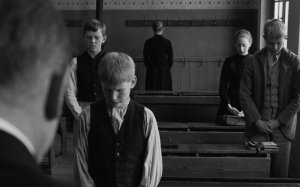The White Ribbon

|
The White Ribbon is set in the fictional Protestant village of Eichwald, Germany in the months leading up to World War I, where a series of mysterious accidents has been plaguing the villagers. Theirs is a society which maintains the appearance of outward calm while simmering with repressed malice and distrust. The extent of the village's dysfunction is revealed through the households of the local pastor (Klaussner), doctor (Bock) and baron (Tukur), whose actions highlight the hypocrisy of the adult world. Throughout the film the children remain eerily impassive, adding a subtle layer of menace to the plot.
Haneke's film is constructed in such a way that everything happening in it can be interpreted symbolically. This transforms the film into a sort of modernist text since the symbols refuse to add up to a convenient, coherent whole. This does not mean that the film is unwatchable, but rather that it declines to serve up tidy answers to the viewer. The entire narrative is itself framed right from the outset as the distant recollections of the village schoolteacher (Friedel, with Ernst Jacobi narrating as his older self), which should act as a caution against taking anything he recounts at face value anyway.
Haneke himself has said that the film is about the origins of terrorism, in all its horrific varieties, and the oppressive mood of the film bears this comment out. Shot beautifully in black and white by Christian Berger, who received an Academy Award nomination in 2009 for Best Cinematography, The White Ribbon is a chilling film precisely because it quickly grows clear to the viewer that there is something horribly wrong with Eichwald, yet the villagers remain completely blind to it, even as their world is slowly poisoned by the encroaching sense of menace.
Ian Chung
More Information | Back to Previous Schedule | This Season | BBFC Classification Guidelines
Screenings of this film:
| 2010/2011 Autumn Term – (35mm) |


